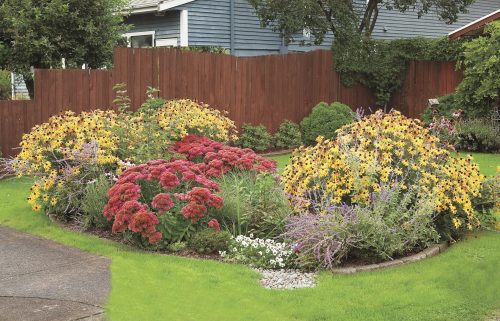Rain Gardens

Rain gardens are bowl-shaped areas in a landscape designed to capture and soak in rainwater from roofs and driveways. Special plants are chosen that can have “wet feet” for a few hours.
Rain gardens add beauty to your yard while reducing the time and resources you will spend maintaining a lawn. These gardens filter pollutants like bacteria and fertilizer. They also help protect against erosion and flooding by reducing the surge of water that rushes to streams during a storm.
Rain gardens hold water for up to two days after a storm, allowing it to slowly soak into the ground. Water should drain in less than 3 days to prevent mosquitoes.
STEPS TO BUILDING A RAIN GARDEN
Find a Good Spot
Observe how water flows in your yard. Choose a location that is between the rainwater source and its destination. You may need to attach a flexible plastic pipe to a downspout to direct water to the garden.
Check the Soil
A simple infiltration test will ensure that the rain garden drains well. Dig a hole 1 foot deep. Fill it with water. If it drains in less than 12 hours, you can build a rain garden. If it drains in 12-36 hours, a rain garden may be possible but you will likely need design help. If it takes more than 36 hours to drain, choose a backyard wetland instead. Call 811 before you dig to check the location of utility lines.
Size the Garden
To size the garden, 1st determine the square footage of roof and driveway area draining to the garden. If 1/2 of your 1,000 square foot roof plus 200 square feet of driveway are contributing runoff to the garden, your total drainage area is 700 square feet.
Next choose a ponding depth of 3 inches or 6 inches. Ponding depth determines how much water your garden will hold during a storm. A ponding depth of 3 inches is best for the clay soils in our area. This means that the garden will be 3 inches below the rest of your landscape.
For a 3-inch deep garden, divide drainage area by 10. Your rain garden would be 70 square feet (700 divided by 10). For a 6-inch deep garden, divide by 20. For a 700 square foot drainage area, the garden would be 35 square feet.
Prepare Soil
For a 3 inch deep rain garden, dig down at least a foot. Then you will want to amend the soil. This is done by taking out 25-50% of the soil in the ground and replacing it with a mix of compost and coarse, washed sand. Use the extra soil you dug out to build a berm on the side of the garden where the water will overflow once the garden is full.
Add 3 inches of double shredded hardwood mulch. The top of the mulch layer should be 3 inches lower than the water entry point.
Plant
Choose plants from a rain garden plant list for our area. North Carolina Cooperative Extension’s guide includes ideas for plants and layouts. Include as many native plants as possible to attract birds and pollinators. Planting in full to partial sun is best. Fall is the ideal planting time.
Maintain
Water your rain garden in the 1st 2 years while plants get established. It should not need watering after the 1st 2 years. Weed as needed. Replace the mulch every 3 years.
Enjoy
Treasure this new addition to your yard. Take pride in doing your part for clean water. Encourage your neighbors to try it.
See more at…https://www.durhamnc.gov/787/Rain-Gardens